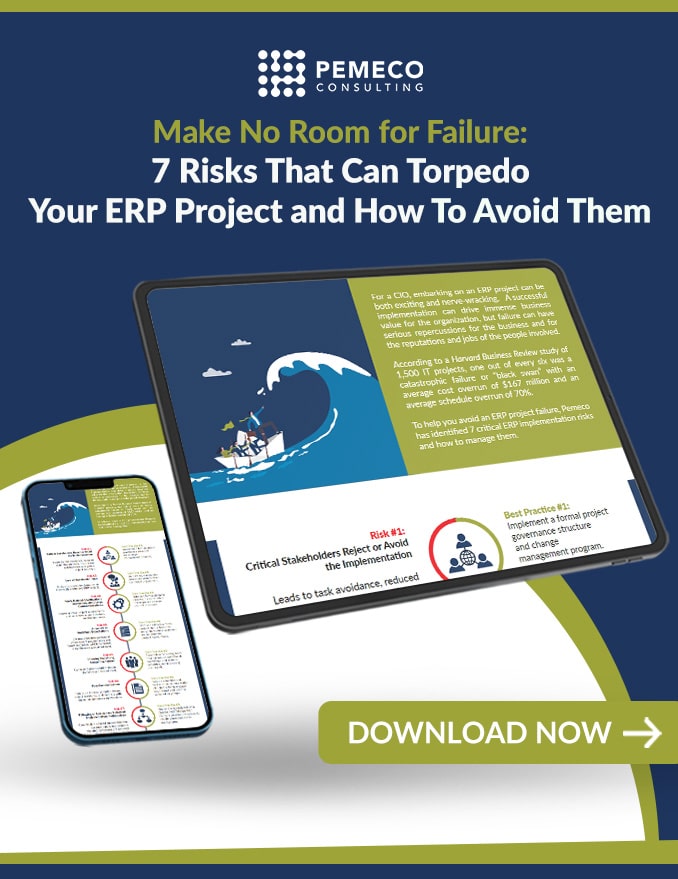Contrary to some popularly held views, implementing enterprise resource planning (ERP) software does not create an inherent conflict with a lean manufacturing philosophy. Sure, material requirements planning (MRP) functions might operate in a manner inconsistent with pure demand-pull systems. But, there’s nothing that requires a company to take an all-or-nothing approach to lean.
In reality, companies that subscribe to lean don’t do so across all business processes. They do so in areas that make practical business sense.
One of our clients, for example, operates a highly automated continuous flow production operation. It leverages formal 5s, Kaizen, and Lean Office practices and procedures. The company’s manufacturing facility is supported by carousels, conveyers, and an integrated shop floor control system. Once an item hits the line, it flows continuously through the shop until it is packed and stocked. When an operator records an operation as complete, the system creates a demand signal that pulls the next item, kit, and/or subassembly to the work station.
Notwithstanding its commitment to lean, this client cannot manage its entire operations with a pull-based system. For example, it relies on MRP to generate batch purchase suggestions for parts and packaging supplies based, in part, on economic order quantities and forecasted material requirements.
Another one of our clients take a different hybrid approach. It plans its master production schedules and material requirements against target levels of finished goods inventory. These buffer stock levels are partly based on demand forecasts and are not perfectly correlated with actual demand.
This latter company’s lean practices and procedures kick in when production orders are released to the shop. A production order creates a demand on a work cell comprised of a logically grouped set of work stations. The company leverages scanning checkpoints to pull orders through production. Materials, labour, and location (work station) are scanned against a work order when the materials enter a work cell, at pre-defined critical operation constraints, and again upon exiting a work cell. The scanning checkpoints serve multiple functions. For one, they allow the company to calculate key metrics relating to takt time (i.e. order cycle time or velocity), operational effectiveness, and labour effectiveness. They also drive the demand-based pull-system. At any point of scan, materials and labour are backflushed through preceding operations, pulling subsequently queued work orders and quantities through the shop.
In both examples, above, the companies rely heavily on their near fully integrated ERP systems to drive their lean initiatives. Below, I break down three common technical and functional ERP capability sets that companies can leverage to drive their lean manufacturing initiatives.
Business Process Optimization
The “Lean Philosophy” is partly defined by continuous efforts to eliminate waste. For companies that do not leverage a fully-integrated ERP system, significant waste exists in the links between business functions.
Companies that do not operate an integrated ERP system are generally exposed to inefficiencies in the interfaces between and across business functions. The pains of siloed functions are typically felt in two areas:
- Difficulty processing transactions across business functions. In these cases, companies typically rely on manual and inefficient processes to receive, record, oftentimes duplicate, and reconcile data to push transactions from one department to another. One common example is a typically cumbersome three-way matching process to process material receipts and pay supplier invoices; and
- Lack of sufficient visibility into operations. The absence of cross-functional integration makes it difficult to generate analytics and track order statuses across an enterprise. With respect to the former, companies typically spend significant time and effort (and cost) aggregating data that ultimately results in reports that are stale by the time they’re fully baked. With respect to the latter, it is not uncommon for customer service and material planners spending significant effort tracking orders within their company.
Integrated ERP systems provide opportunities to reduce cross-functional waste by automating record reconciliations, automating cross-functional transaction processing, and improving operational visibility.
In many cases, these types of capabilities are delivered as standard ERP functionality. Where required functionality is not standard, companies might be able to leverage a system’s business process management – or workflow – capabilities. One common workflow example is the automation of an approval process relating to purchase order requests that exceed a defined threshold. Many modern ERP systems can push those notification events – and accept, reject, or modify action responses – to the approver via any device.
Ultimately, these types of solutions provide opportunities to both streamline and increase the velocity of business processing and reporting.
Standard Work Instructions
Standard work instructions comprise another common lean tool.
Many companies still utilize paper-based shop travellers and job packs to communicate work instructions to the shop floor. Inefficiencies in these manual processes can relate to document sharing, document preservation, production control, and quality assurance functions. An example of the latter includes procedures to ensure that the shop is manufacturing to the applicable production version of an item.
In an integrated ERP environment, standard work instructions can be electronically stored and maintained. Integrated functionality helps ensure adequate procedures and controls by, for example, linking the correct production version to a customer sales order or work order. Another benefit, for example, is an ability to deploy work instructions in electronic format to tablets or monitors fitted at work cells or stations. This mitigates document preservation and quality assurance risks associated with physical document check-in/check-out procedures.
Replenishment
Most sophisticated manufacturing ERP systems support manual or automated kanban and two-bin replenishment systems.
Automated kanban – or ekanban – is intended to reduce errors associated with a manual card system (cards can get misplaced or not acted upon in a timely manner). In an ekanban environment, bins are fitted with sensors that trigger automated signals.
When consumption hits a certain threshold, a signal can trigger replenishment requirements in ERP. ERP can be configured to automatically cut purchase orders, create purchase order suggestions, or signal vendors to replenish their vendor managed inventory stores.
Configuring ERP to Drive your Company’s Lean Initiatives
The above examples merely scratch the surface as to how companies are leveraging their integrated ERP systems to drive lean initiatives. We have some clients that leverage production analytics to improve operational effectiveness by reducing machine downtime, changeovers, and cleans. Other clients integrate their manufacturing execution, laboratory information management, and ERP systems in an effort to automate production equipment calibration and reduce scrap rates from manual calibrations.
The bottom line is this: only imagination limits how companies can leverage their ERP systems to drive their lean initiatives. As with any lean program, the key to success is honing in on the initiatives that are strategically and/or operationally valuable.





